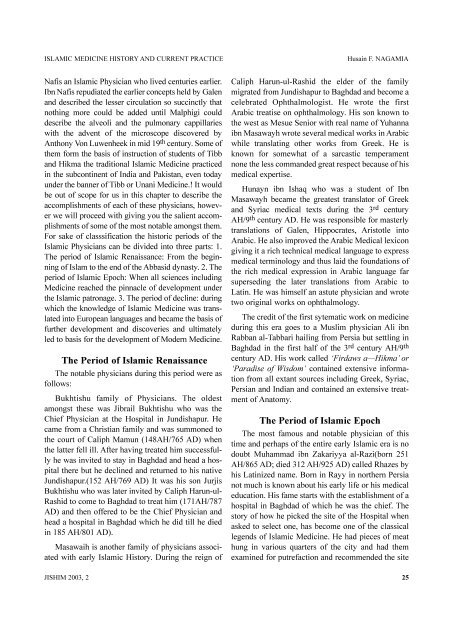Islamic Medicine History and Current Practice - International Society ...
Islamic Medicine History and Current Practice - International Society ...
Islamic Medicine History and Current Practice - International Society ...
- No tags were found...
You also want an ePaper? Increase the reach of your titles
YUMPU automatically turns print PDFs into web optimized ePapers that Google loves.
ISLAMIC MEDICINE HISTORY AND CURRENT PRACTICEHusain F. NAGAMIANafis an <strong>Islamic</strong> Physician who lived centuries earlier.Ibn Nafis repudiated the earlier concepts held by Galen<strong>and</strong> described the lesser circulation so succinctly thatnothing more could be added until Malphigi coulddescribe the alveoli <strong>and</strong> the pulmonary cappillarieswith the advent of the microscope discovered byAnthony Von Luwenheek in mid 19 th century. Some ofthem form the basis of instruction of students of Tibb<strong>and</strong> Hikma the traditional <strong>Islamic</strong> <strong>Medicine</strong> practicedin the subcontinent of India <strong>and</strong> Pakistan, even todayunder the banner of Tibb or Unani <strong>Medicine</strong>.! It wouldbe out of scope for us in this chapter to describe theaccomplishments of each of these physicians, howeverwe will proceed with giving you the salient accomplishmentsof some of the most notable amongst them.For sake of classsification the historic periods of the<strong>Islamic</strong> Physicians can be divided into three parts: 1.The period of <strong>Islamic</strong> Renaissance: From the beginningof Islam to the end of the Abbasid dynasty. 2. Theperiod of <strong>Islamic</strong> Epoch: When all sciences including<strong>Medicine</strong> reached the pinnacle of development underthe <strong>Islamic</strong> patronage. 3. The period of decline: duringwhich the knowledge of <strong>Islamic</strong> <strong>Medicine</strong> was translatedinto European languages <strong>and</strong> became the basis offurther development <strong>and</strong> discoveries <strong>and</strong> ultimatelyled to basis for the development of Modern <strong>Medicine</strong>.The Period of <strong>Islamic</strong> RenaissanceThe notable physicians during this period were asfollows:Bukhtishu family of Physicians. The oldestamongst these was Jibrail Bukhtishu who was theChief Physician at the Hospital in Jundishapur. Hecame from a Christian family <strong>and</strong> was summoned tothe court of Caliph Mamun (148AH/765 AD) whenthe latter fell ill. After having treated him successfullyhe was invited to stay in Baghdad <strong>and</strong> head a hospitalthere but he declined <strong>and</strong> returned to his nativeJundishapur.(152 AH/769 AD) It was his son JurjisBukhtishu who was later invited by Caliph Harun-ul-Rashid to come to Baghdad to treat him (171AH/787AD) <strong>and</strong> then offered to be the Chief Physician <strong>and</strong>head a hospital in Baghdad which he did till he diedin 185 AH/801 AD).Masawaih is another family of physicians associatedwith early <strong>Islamic</strong> <strong>History</strong>. During the reign ofCaliph Harun-ul-Rashid the elder of the familymigrated from Jundishapur to Baghdad <strong>and</strong> become acelebrated Ophthalmologist. He wrote the firstArabic treatise on ophthalmology. His son known tothe west as Mesue Senior with real name of Yuhannaibn Masawayh wrote several medical works in Arabicwhile translating other works from Greek. He isknown for somewhat of a sarcastic temperamentnone the less comm<strong>and</strong>ed great respect because of hismedical expertise.Hunayn ibn Ishaq who was a student of IbnMasawayh became the greatest translator of Greek<strong>and</strong> Syriac medical texts during the 3 rd centuryAH/9 th century AD. He was responsible for masterlytranslations of Galen, Hippocrates, Aristotle intoArabic. He also improved the Arabic Medical lexicongiving it a rich technical medical language to expressmedical terminology <strong>and</strong> thus laid the foundations ofthe rich medical expression in Arabic language farsuperseding the later translations from Arabic toLatin. He was himself an astute physician <strong>and</strong> wrotetwo original works on ophthalmology.The credit of the first sytematic work on medicineduring this era goes to a Muslim physician Ali ibnRabban al-Tabbari hailing from Persia but settling inBaghdad in the first half of the 3 rd century AH/9 thcentury AD. His work called ‘Firdaws a—Hikma’ or‘Paradise of Wisdom’ contained extensive informationfrom all extant sources including Greek, Syriac,Persian <strong>and</strong> Indian <strong>and</strong> contained an extensive treatmentof Anatomy.The Period of <strong>Islamic</strong> EpochThe most famous <strong>and</strong> notable physician of thistime <strong>and</strong> perhaps of the entire early <strong>Islamic</strong> era is nodoubt Muhammad ibn Zakariyya al-Razi(born 251AH/865 AD; died 312 AH/925 AD) called Rhazes byhis Latinized name. Born in Rayy in northern Persianot much is known about his early life or his medicaleducation. His fame starts with the establishment of ahospital in Baghdad of which he was the chief. Thestory of how he picked the site of the Hospital whenasked to select one, has become one of the classicallegends of <strong>Islamic</strong> <strong>Medicine</strong>. He had pieces of meathung in various quarters of the city <strong>and</strong> had themexamined for putrefaction <strong>and</strong> recommended the siteJISHIM 2003, 225
















